Identifying Entrepreneurial Opportunities : PDF
VerifiedAdded on 2020/12/18
|18
|4718
|377
AI Summary
Contribute Materials
Your contribution can guide someone’s learning journey. Share your
documents today.
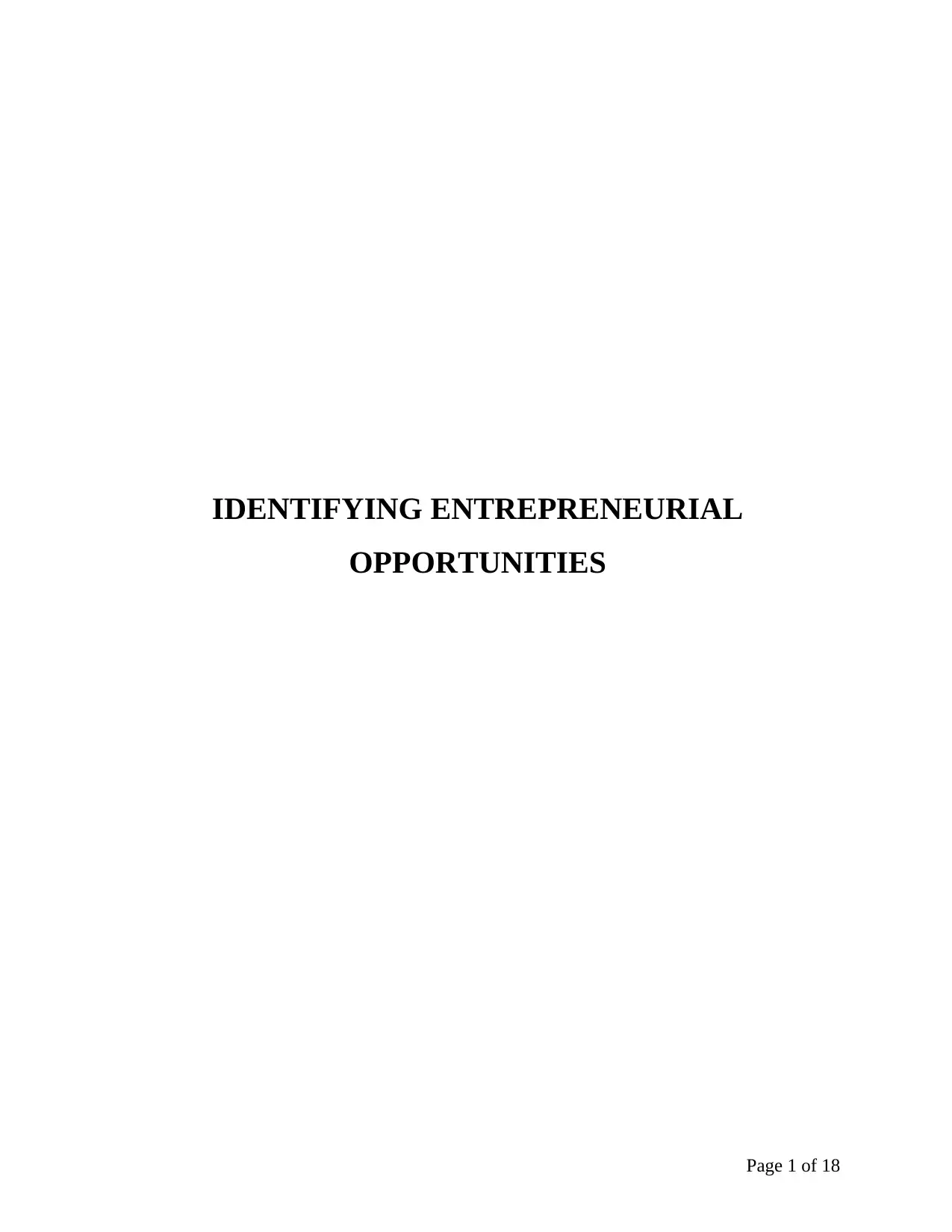
IDENTIFYING ENTREPRENEURIAL
OPPORTUNITIES
Page 1 of 18
OPPORTUNITIES
Page 1 of 18
Secure Best Marks with AI Grader
Need help grading? Try our AI Grader for instant feedback on your assignments.
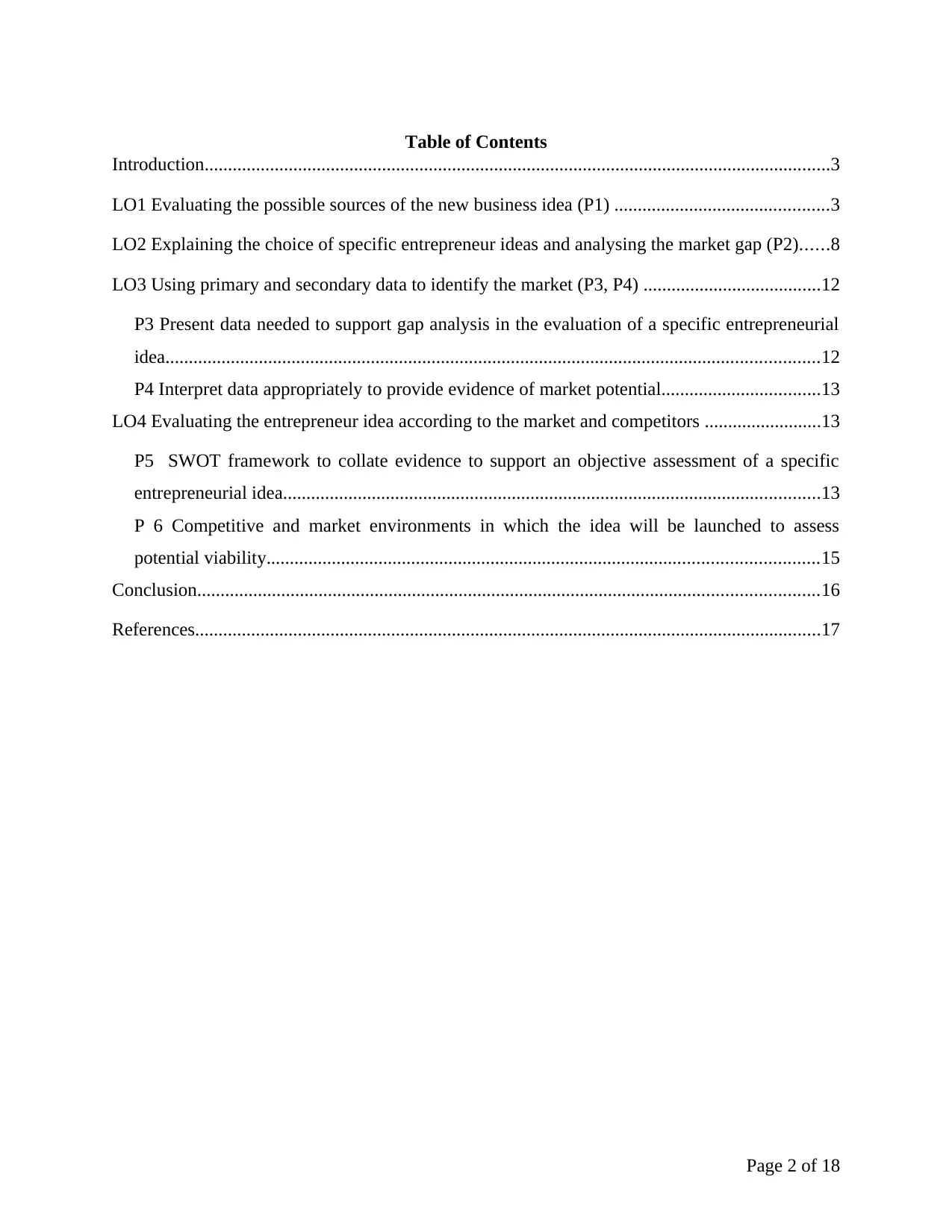
Table of Contents
Introduction......................................................................................................................................3
LO1 Evaluating the possible sources of the new business idea (P1) ..............................................3
LO2 Explaining the choice of specific entrepreneur ideas and analysing the market gap (P2)......8
LO3 Using primary and secondary data to identify the market (P3, P4) ......................................12
P3 Present data needed to support gap analysis in the evaluation of a specific entrepreneurial
idea............................................................................................................................................12
P4 Interpret data appropriately to provide evidence of market potential..................................13
LO4 Evaluating the entrepreneur idea according to the market and competitors .........................13
P5 SWOT framework to collate evidence to support an objective assessment of a specific
entrepreneurial idea...................................................................................................................13
P 6 Competitive and market environments in which the idea will be launched to assess
potential viability......................................................................................................................15
Conclusion.....................................................................................................................................16
References......................................................................................................................................17
Page 2 of 18
Introduction......................................................................................................................................3
LO1 Evaluating the possible sources of the new business idea (P1) ..............................................3
LO2 Explaining the choice of specific entrepreneur ideas and analysing the market gap (P2)......8
LO3 Using primary and secondary data to identify the market (P3, P4) ......................................12
P3 Present data needed to support gap analysis in the evaluation of a specific entrepreneurial
idea............................................................................................................................................12
P4 Interpret data appropriately to provide evidence of market potential..................................13
LO4 Evaluating the entrepreneur idea according to the market and competitors .........................13
P5 SWOT framework to collate evidence to support an objective assessment of a specific
entrepreneurial idea...................................................................................................................13
P 6 Competitive and market environments in which the idea will be launched to assess
potential viability......................................................................................................................15
Conclusion.....................................................................................................................................16
References......................................................................................................................................17
Page 2 of 18
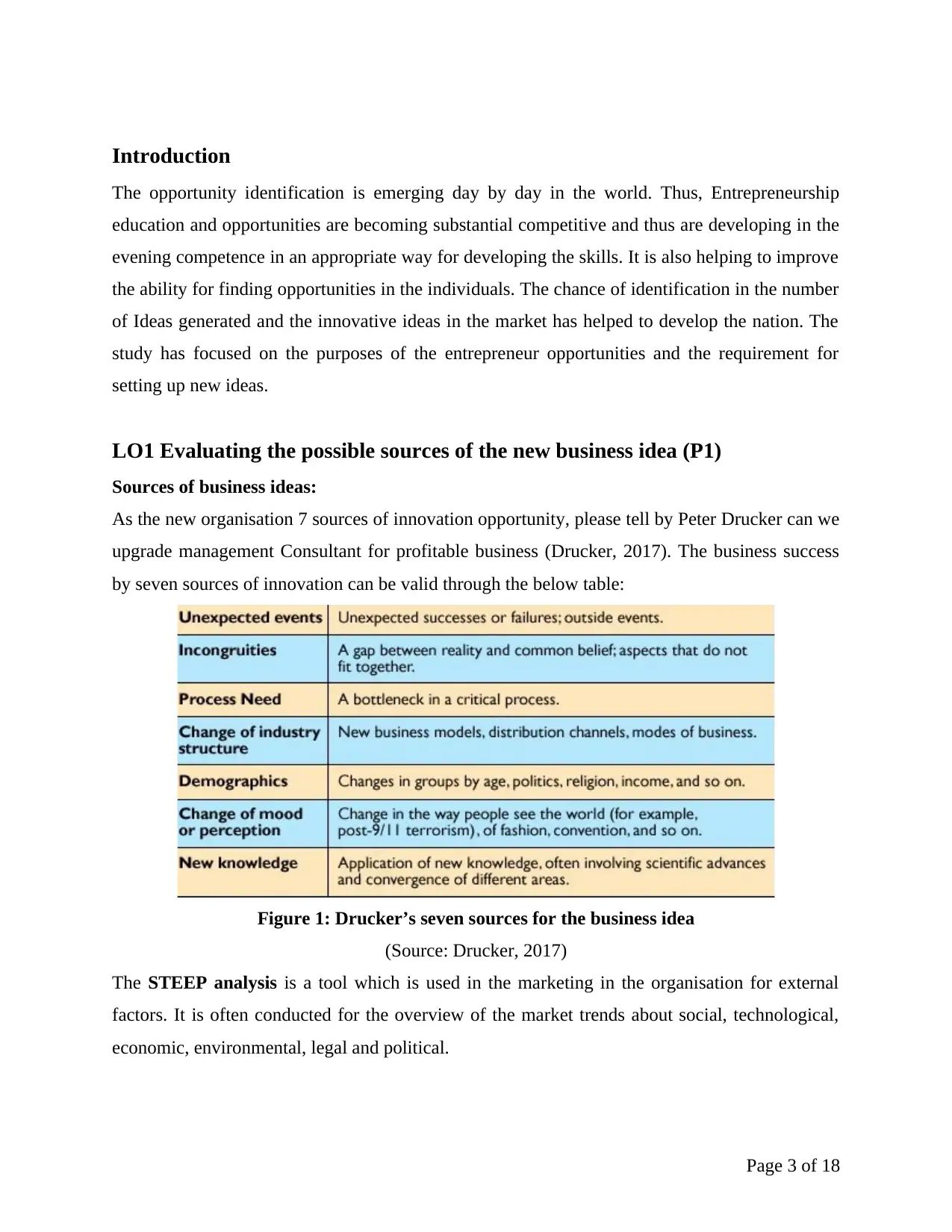
Introduction
The opportunity identification is emerging day by day in the world. Thus, Entrepreneurship
education and opportunities are becoming substantial competitive and thus are developing in the
evening competence in an appropriate way for developing the skills. It is also helping to improve
the ability for finding opportunities in the individuals. The chance of identification in the number
of Ideas generated and the innovative ideas in the market has helped to develop the nation. The
study has focused on the purposes of the entrepreneur opportunities and the requirement for
setting up new ideas.
LO1 Evaluating the possible sources of the new business idea (P1)
Sources of business ideas:
As the new organisation 7 sources of innovation opportunity, please tell by Peter Drucker can we
upgrade management Consultant for profitable business (Drucker, 2017). The business success
by seven sources of innovation can be valid through the below table:
Figure 1: Drucker’s seven sources for the business idea
(Source: Drucker, 2017)
The STEEP analysis is a tool which is used in the marketing in the organisation for external
factors. It is often conducted for the overview of the market trends about social, technological,
economic, environmental, legal and political.
Page 3 of 18
The opportunity identification is emerging day by day in the world. Thus, Entrepreneurship
education and opportunities are becoming substantial competitive and thus are developing in the
evening competence in an appropriate way for developing the skills. It is also helping to improve
the ability for finding opportunities in the individuals. The chance of identification in the number
of Ideas generated and the innovative ideas in the market has helped to develop the nation. The
study has focused on the purposes of the entrepreneur opportunities and the requirement for
setting up new ideas.
LO1 Evaluating the possible sources of the new business idea (P1)
Sources of business ideas:
As the new organisation 7 sources of innovation opportunity, please tell by Peter Drucker can we
upgrade management Consultant for profitable business (Drucker, 2017). The business success
by seven sources of innovation can be valid through the below table:
Figure 1: Drucker’s seven sources for the business idea
(Source: Drucker, 2017)
The STEEP analysis is a tool which is used in the marketing in the organisation for external
factors. It is often conducted for the overview of the market trends about social, technological,
economic, environmental, legal and political.
Page 3 of 18
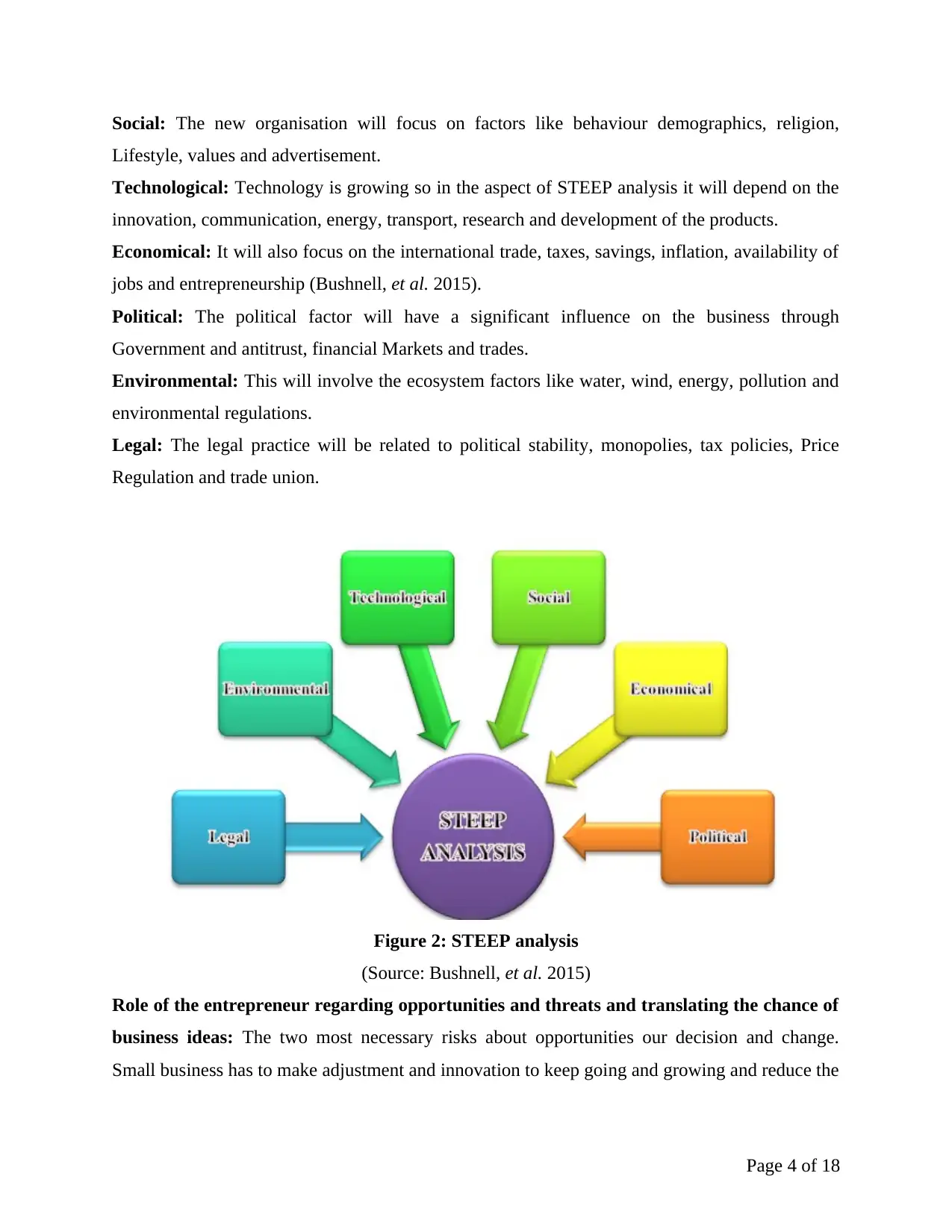
Social: The new organisation will focus on factors like behaviour demographics, religion,
Lifestyle, values and advertisement.
Technological: Technology is growing so in the aspect of STEEP analysis it will depend on the
innovation, communication, energy, transport, research and development of the products.
Economical: It will also focus on the international trade, taxes, savings, inflation, availability of
jobs and entrepreneurship (Bushnell, et al. 2015).
Political: The political factor will have a significant influence on the business through
Government and antitrust, financial Markets and trades.
Environmental: This will involve the ecosystem factors like water, wind, energy, pollution and
environmental regulations.
Legal: The legal practice will be related to political stability, monopolies, tax policies, Price
Regulation and trade union.
Figure 2: STEEP analysis
(Source: Bushnell, et al. 2015)
Role of the entrepreneur regarding opportunities and threats and translating the chance of
business ideas: The two most necessary risks about opportunities our decision and change.
Small business has to make adjustment and innovation to keep going and growing and reduce the
Page 4 of 18
Lifestyle, values and advertisement.
Technological: Technology is growing so in the aspect of STEEP analysis it will depend on the
innovation, communication, energy, transport, research and development of the products.
Economical: It will also focus on the international trade, taxes, savings, inflation, availability of
jobs and entrepreneurship (Bushnell, et al. 2015).
Political: The political factor will have a significant influence on the business through
Government and antitrust, financial Markets and trades.
Environmental: This will involve the ecosystem factors like water, wind, energy, pollution and
environmental regulations.
Legal: The legal practice will be related to political stability, monopolies, tax policies, Price
Regulation and trade union.
Figure 2: STEEP analysis
(Source: Bushnell, et al. 2015)
Role of the entrepreneur regarding opportunities and threats and translating the chance of
business ideas: The two most necessary risks about opportunities our decision and change.
Small business has to make adjustment and innovation to keep going and growing and reduce the
Page 4 of 18
Secure Best Marks with AI Grader
Need help grading? Try our AI Grader for instant feedback on your assignments.
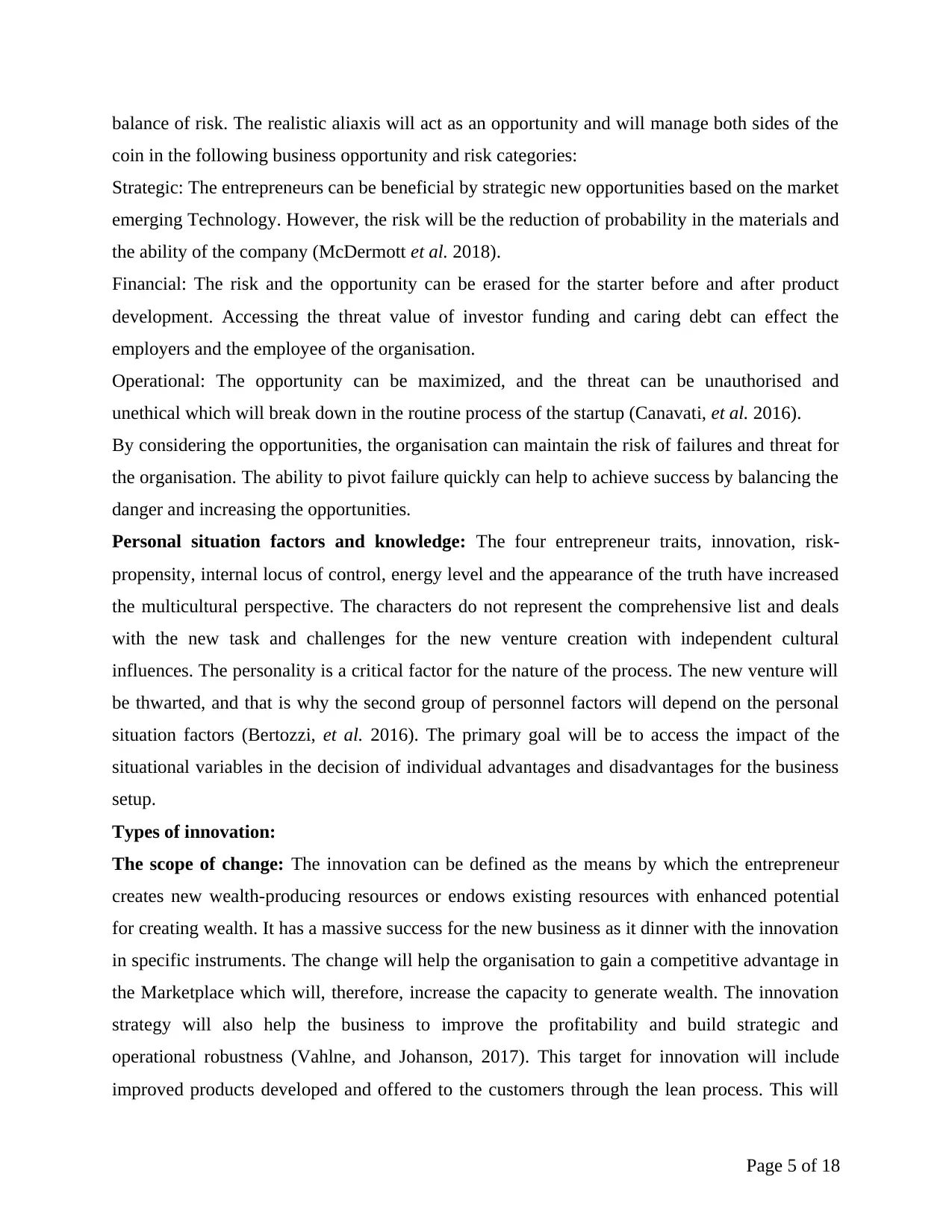
balance of risk. The realistic aliaxis will act as an opportunity and will manage both sides of the
coin in the following business opportunity and risk categories:
Strategic: The entrepreneurs can be beneficial by strategic new opportunities based on the market
emerging Technology. However, the risk will be the reduction of probability in the materials and
the ability of the company (McDermott et al. 2018).
Financial: The risk and the opportunity can be erased for the starter before and after product
development. Accessing the threat value of investor funding and caring debt can effect the
employers and the employee of the organisation.
Operational: The opportunity can be maximized, and the threat can be unauthorised and
unethical which will break down in the routine process of the startup (Canavati, et al. 2016).
By considering the opportunities, the organisation can maintain the risk of failures and threat for
the organisation. The ability to pivot failure quickly can help to achieve success by balancing the
danger and increasing the opportunities.
Personal situation factors and knowledge: The four entrepreneur traits, innovation, risk-
propensity, internal locus of control, energy level and the appearance of the truth have increased
the multicultural perspective. The characters do not represent the comprehensive list and deals
with the new task and challenges for the new venture creation with independent cultural
influences. The personality is a critical factor for the nature of the process. The new venture will
be thwarted, and that is why the second group of personnel factors will depend on the personal
situation factors (Bertozzi, et al. 2016). The primary goal will be to access the impact of the
situational variables in the decision of individual advantages and disadvantages for the business
setup.
Types of innovation:
The scope of change: The innovation can be defined as the means by which the entrepreneur
creates new wealth-producing resources or endows existing resources with enhanced potential
for creating wealth. It has a massive success for the new business as it dinner with the innovation
in specific instruments. The change will help the organisation to gain a competitive advantage in
the Marketplace which will, therefore, increase the capacity to generate wealth. The innovation
strategy will also help the business to improve the profitability and build strategic and
operational robustness (Vahlne, and Johanson, 2017). This target for innovation will include
improved products developed and offered to the customers through the lean process. This will
Page 5 of 18
coin in the following business opportunity and risk categories:
Strategic: The entrepreneurs can be beneficial by strategic new opportunities based on the market
emerging Technology. However, the risk will be the reduction of probability in the materials and
the ability of the company (McDermott et al. 2018).
Financial: The risk and the opportunity can be erased for the starter before and after product
development. Accessing the threat value of investor funding and caring debt can effect the
employers and the employee of the organisation.
Operational: The opportunity can be maximized, and the threat can be unauthorised and
unethical which will break down in the routine process of the startup (Canavati, et al. 2016).
By considering the opportunities, the organisation can maintain the risk of failures and threat for
the organisation. The ability to pivot failure quickly can help to achieve success by balancing the
danger and increasing the opportunities.
Personal situation factors and knowledge: The four entrepreneur traits, innovation, risk-
propensity, internal locus of control, energy level and the appearance of the truth have increased
the multicultural perspective. The characters do not represent the comprehensive list and deals
with the new task and challenges for the new venture creation with independent cultural
influences. The personality is a critical factor for the nature of the process. The new venture will
be thwarted, and that is why the second group of personnel factors will depend on the personal
situation factors (Bertozzi, et al. 2016). The primary goal will be to access the impact of the
situational variables in the decision of individual advantages and disadvantages for the business
setup.
Types of innovation:
The scope of change: The innovation can be defined as the means by which the entrepreneur
creates new wealth-producing resources or endows existing resources with enhanced potential
for creating wealth. It has a massive success for the new business as it dinner with the innovation
in specific instruments. The change will help the organisation to gain a competitive advantage in
the Marketplace which will, therefore, increase the capacity to generate wealth. The innovation
strategy will also help the business to improve the profitability and build strategic and
operational robustness (Vahlne, and Johanson, 2017). This target for innovation will include
improved products developed and offered to the customers through the lean process. This will
Page 5 of 18
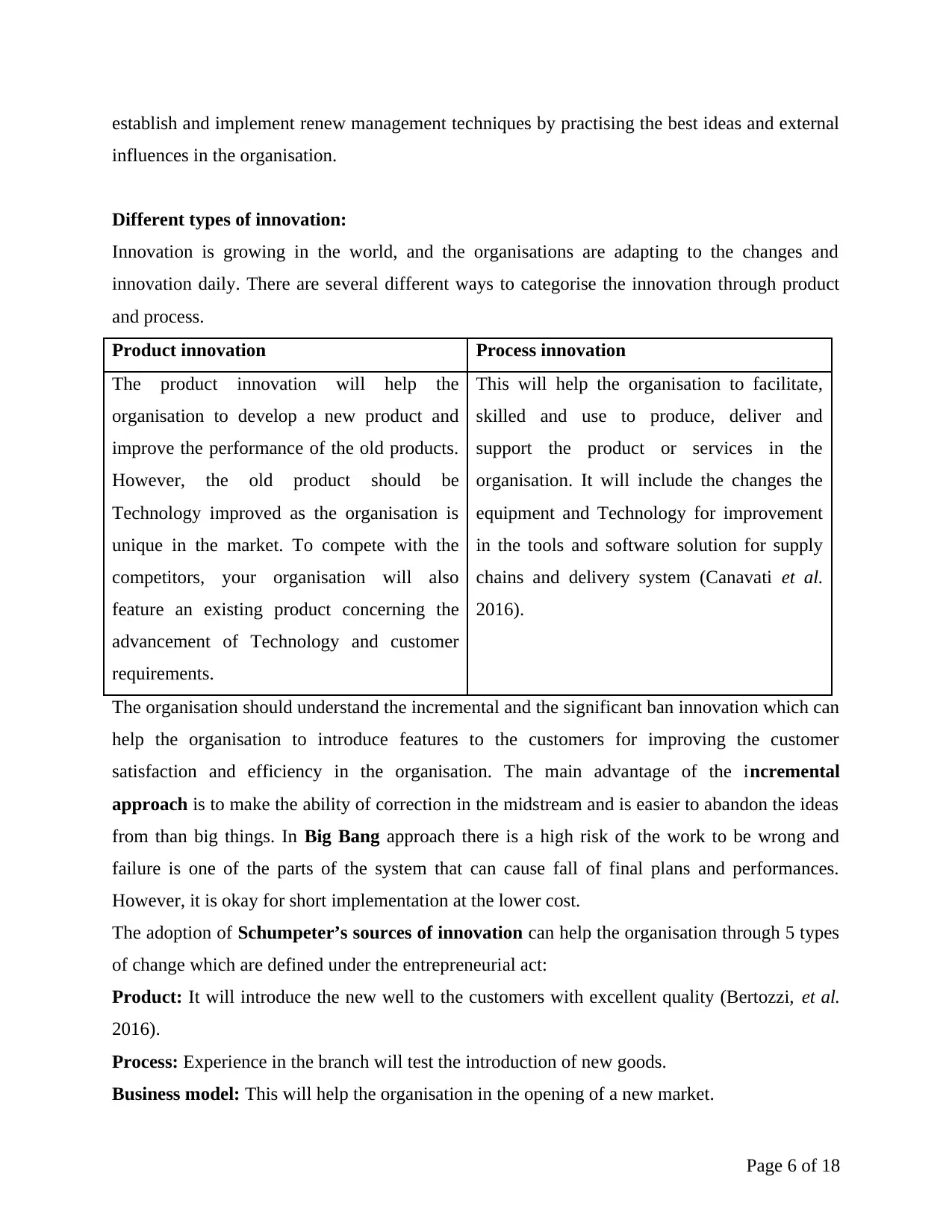
establish and implement renew management techniques by practising the best ideas and external
influences in the organisation.
Different types of innovation:
Innovation is growing in the world, and the organisations are adapting to the changes and
innovation daily. There are several different ways to categorise the innovation through product
and process.
Product innovation Process innovation
The product innovation will help the
organisation to develop a new product and
improve the performance of the old products.
However, the old product should be
Technology improved as the organisation is
unique in the market. To compete with the
competitors, your organisation will also
feature an existing product concerning the
advancement of Technology and customer
requirements.
This will help the organisation to facilitate,
skilled and use to produce, deliver and
support the product or services in the
organisation. It will include the changes the
equipment and Technology for improvement
in the tools and software solution for supply
chains and delivery system (Canavati et al.
2016).
The organisation should understand the incremental and the significant ban innovation which can
help the organisation to introduce features to the customers for improving the customer
satisfaction and efficiency in the organisation. The main advantage of the incremental
approach is to make the ability of correction in the midstream and is easier to abandon the ideas
from than big things. In Big Bang approach there is a high risk of the work to be wrong and
failure is one of the parts of the system that can cause fall of final plans and performances.
However, it is okay for short implementation at the lower cost.
The adoption of Schumpeter’s sources of innovation can help the organisation through 5 types
of change which are defined under the entrepreneurial act:
Product: It will introduce the new well to the customers with excellent quality (Bertozzi, et al.
2016).
Process: Experience in the branch will test the introduction of new goods.
Business model: This will help the organisation in the opening of a new market.
Page 6 of 18
influences in the organisation.
Different types of innovation:
Innovation is growing in the world, and the organisations are adapting to the changes and
innovation daily. There are several different ways to categorise the innovation through product
and process.
Product innovation Process innovation
The product innovation will help the
organisation to develop a new product and
improve the performance of the old products.
However, the old product should be
Technology improved as the organisation is
unique in the market. To compete with the
competitors, your organisation will also
feature an existing product concerning the
advancement of Technology and customer
requirements.
This will help the organisation to facilitate,
skilled and use to produce, deliver and
support the product or services in the
organisation. It will include the changes the
equipment and Technology for improvement
in the tools and software solution for supply
chains and delivery system (Canavati et al.
2016).
The organisation should understand the incremental and the significant ban innovation which can
help the organisation to introduce features to the customers for improving the customer
satisfaction and efficiency in the organisation. The main advantage of the incremental
approach is to make the ability of correction in the midstream and is easier to abandon the ideas
from than big things. In Big Bang approach there is a high risk of the work to be wrong and
failure is one of the parts of the system that can cause fall of final plans and performances.
However, it is okay for short implementation at the lower cost.
The adoption of Schumpeter’s sources of innovation can help the organisation through 5 types
of change which are defined under the entrepreneurial act:
Product: It will introduce the new well to the customers with excellent quality (Bertozzi, et al.
2016).
Process: Experience in the branch will test the introduction of new goods.
Business model: This will help the organisation in the opening of a new market.
Page 6 of 18
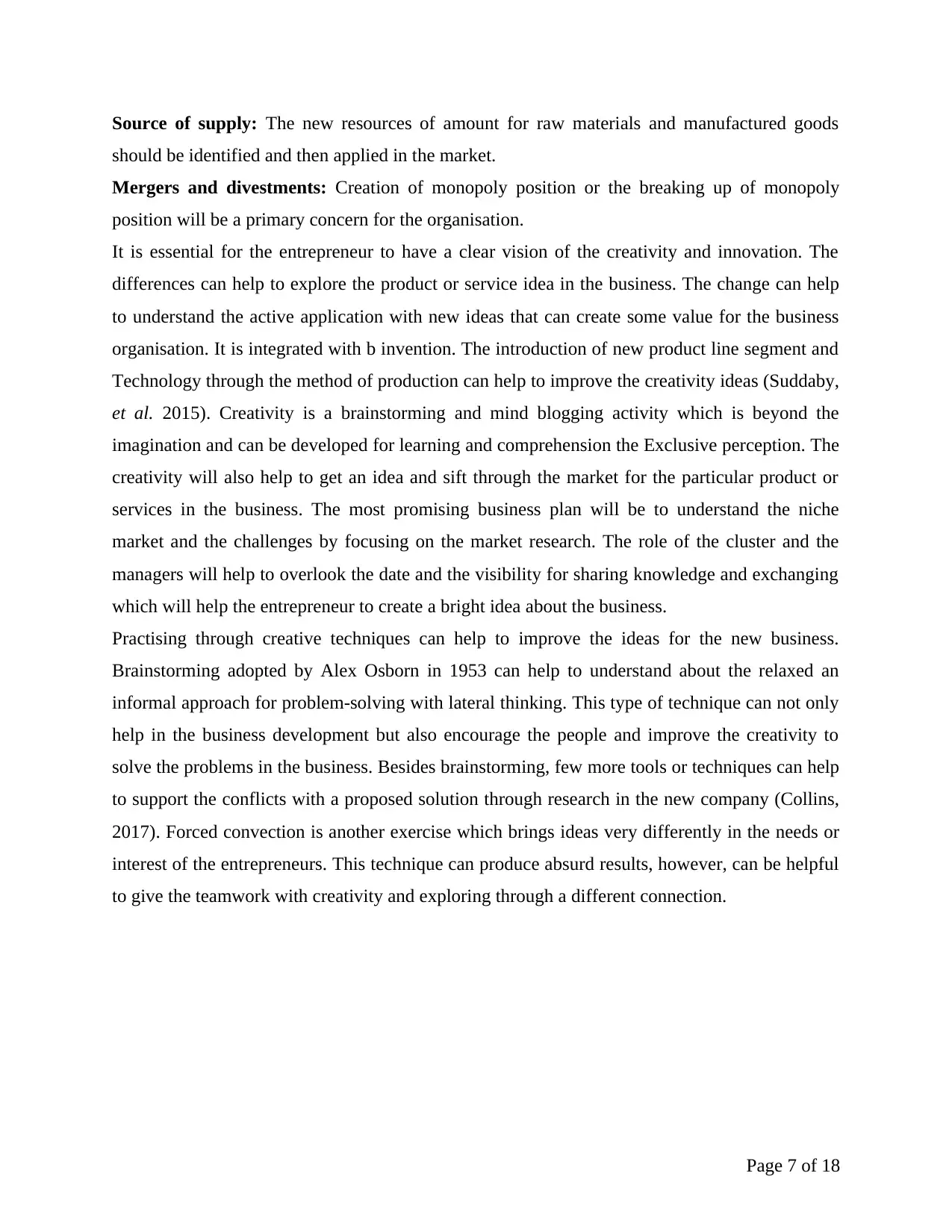
Source of supply: The new resources of amount for raw materials and manufactured goods
should be identified and then applied in the market.
Mergers and divestments: Creation of monopoly position or the breaking up of monopoly
position will be a primary concern for the organisation.
It is essential for the entrepreneur to have a clear vision of the creativity and innovation. The
differences can help to explore the product or service idea in the business. The change can help
to understand the active application with new ideas that can create some value for the business
organisation. It is integrated with b invention. The introduction of new product line segment and
Technology through the method of production can help to improve the creativity ideas (Suddaby,
et al. 2015). Creativity is a brainstorming and mind blogging activity which is beyond the
imagination and can be developed for learning and comprehension the Exclusive perception. The
creativity will also help to get an idea and sift through the market for the particular product or
services in the business. The most promising business plan will be to understand the niche
market and the challenges by focusing on the market research. The role of the cluster and the
managers will help to overlook the date and the visibility for sharing knowledge and exchanging
which will help the entrepreneur to create a bright idea about the business.
Practising through creative techniques can help to improve the ideas for the new business.
Brainstorming adopted by Alex Osborn in 1953 can help to understand about the relaxed an
informal approach for problem-solving with lateral thinking. This type of technique can not only
help in the business development but also encourage the people and improve the creativity to
solve the problems in the business. Besides brainstorming, few more tools or techniques can help
to support the conflicts with a proposed solution through research in the new company (Collins,
2017). Forced convection is another exercise which brings ideas very differently in the needs or
interest of the entrepreneurs. This technique can produce absurd results, however, can be helpful
to give the teamwork with creativity and exploring through a different connection.
Page 7 of 18
should be identified and then applied in the market.
Mergers and divestments: Creation of monopoly position or the breaking up of monopoly
position will be a primary concern for the organisation.
It is essential for the entrepreneur to have a clear vision of the creativity and innovation. The
differences can help to explore the product or service idea in the business. The change can help
to understand the active application with new ideas that can create some value for the business
organisation. It is integrated with b invention. The introduction of new product line segment and
Technology through the method of production can help to improve the creativity ideas (Suddaby,
et al. 2015). Creativity is a brainstorming and mind blogging activity which is beyond the
imagination and can be developed for learning and comprehension the Exclusive perception. The
creativity will also help to get an idea and sift through the market for the particular product or
services in the business. The most promising business plan will be to understand the niche
market and the challenges by focusing on the market research. The role of the cluster and the
managers will help to overlook the date and the visibility for sharing knowledge and exchanging
which will help the entrepreneur to create a bright idea about the business.
Practising through creative techniques can help to improve the ideas for the new business.
Brainstorming adopted by Alex Osborn in 1953 can help to understand about the relaxed an
informal approach for problem-solving with lateral thinking. This type of technique can not only
help in the business development but also encourage the people and improve the creativity to
solve the problems in the business. Besides brainstorming, few more tools or techniques can help
to support the conflicts with a proposed solution through research in the new company (Collins,
2017). Forced convection is another exercise which brings ideas very differently in the needs or
interest of the entrepreneurs. This technique can produce absurd results, however, can be helpful
to give the teamwork with creativity and exploring through a different connection.
Page 7 of 18
Paraphrase This Document
Need a fresh take? Get an instant paraphrase of this document with our AI Paraphraser
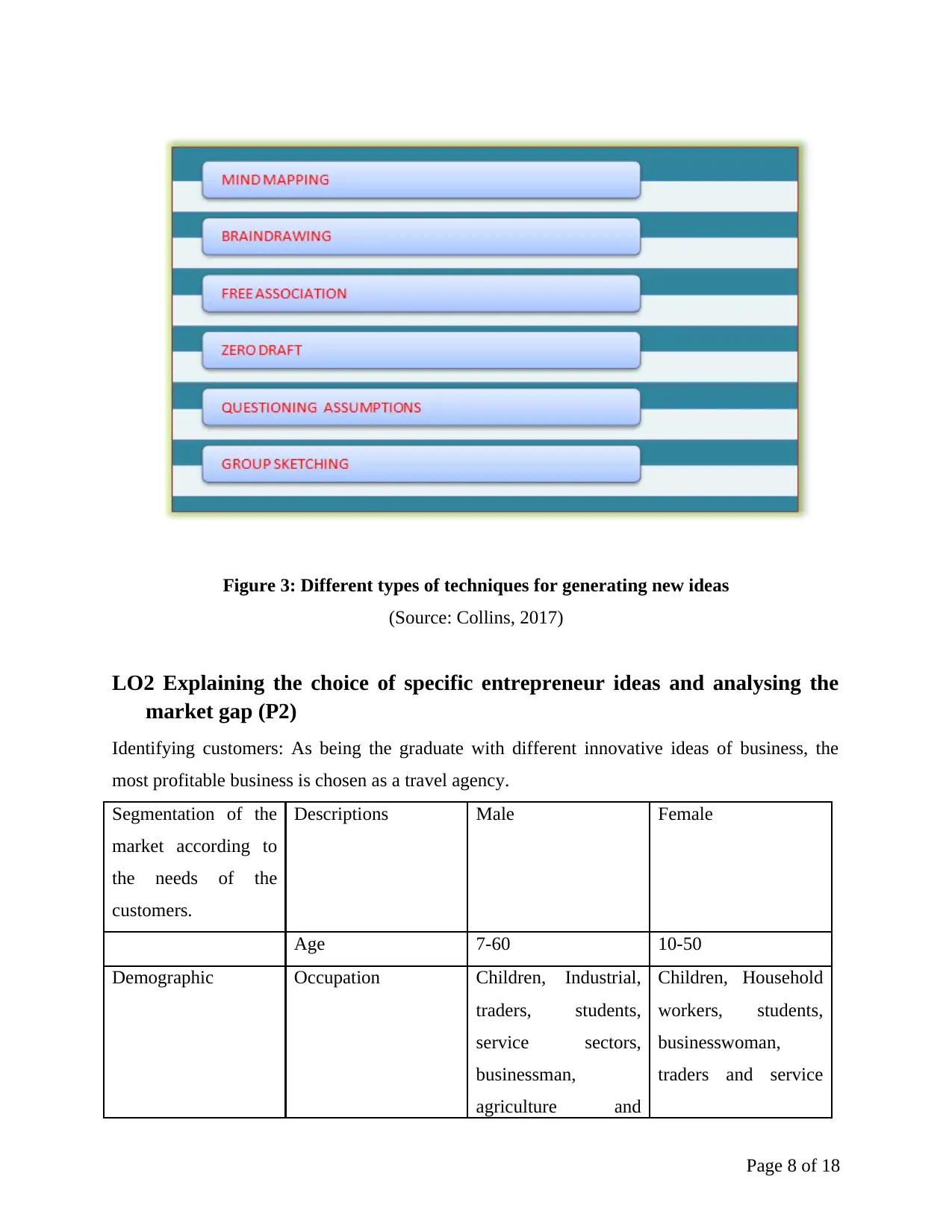
Figure 3: Different types of techniques for generating new ideas
(Source: Collins, 2017)
LO2 Explaining the choice of specific entrepreneur ideas and analysing the
market gap (P2)
Identifying customers: As being the graduate with different innovative ideas of business, the
most profitable business is chosen as a travel agency.
Segmentation of the
market according to
the needs of the
customers.
Descriptions Male Female
Age 7-60 10-50
Demographic Occupation Children, Industrial,
traders, students,
service sectors,
businessman,
agriculture and
Children, Household
workers, students,
businesswoman,
traders and service
Page 8 of 18
(Source: Collins, 2017)
LO2 Explaining the choice of specific entrepreneur ideas and analysing the
market gap (P2)
Identifying customers: As being the graduate with different innovative ideas of business, the
most profitable business is chosen as a travel agency.
Segmentation of the
market according to
the needs of the
customers.
Descriptions Male Female
Age 7-60 10-50
Demographic Occupation Children, Industrial,
traders, students,
service sectors,
businessman,
agriculture and
Children, Household
workers, students,
businesswoman,
traders and service
Page 8 of 18
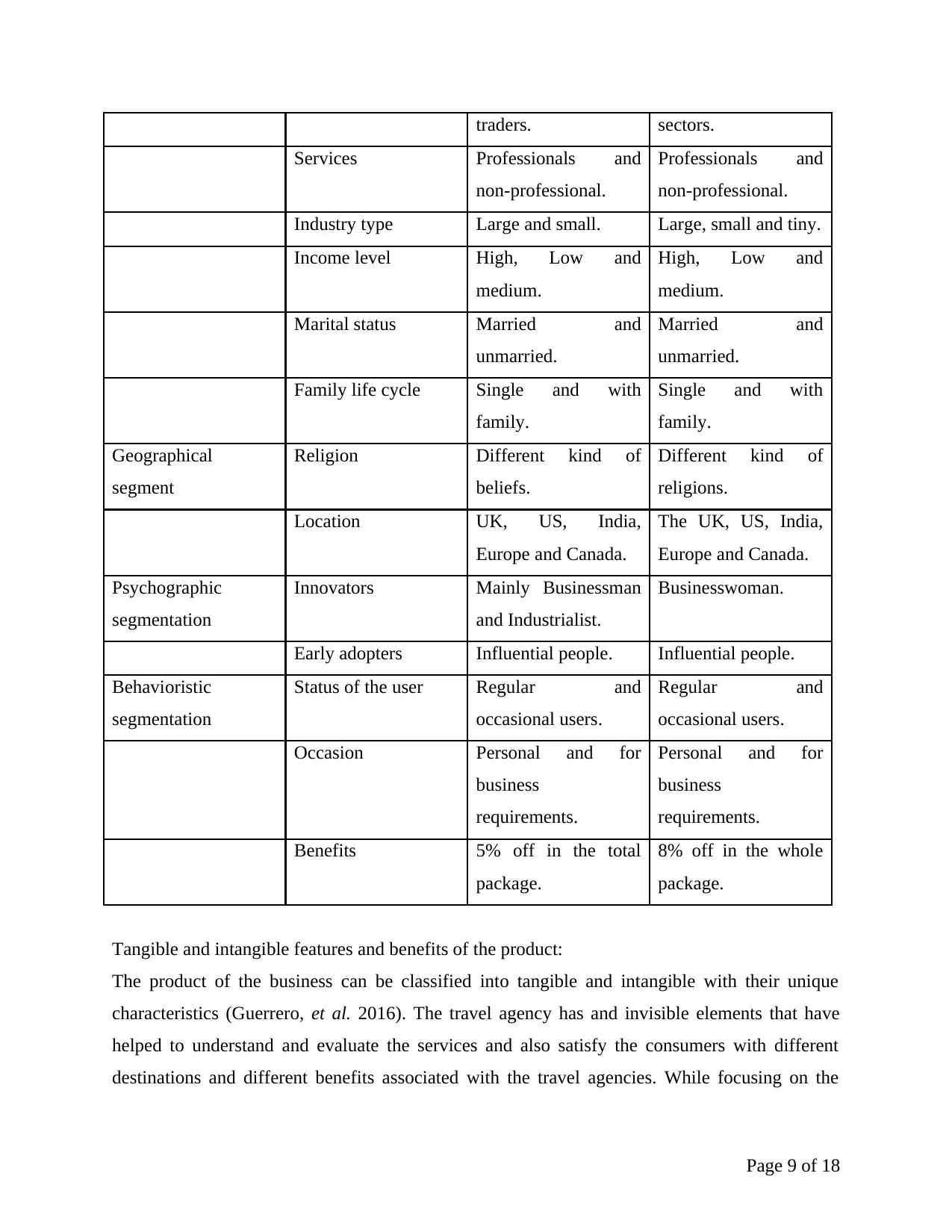
traders. sectors.
Services Professionals and
non-professional.
Professionals and
non-professional.
Industry type Large and small. Large, small and tiny.
Income level High, Low and
medium.
High, Low and
medium.
Marital status Married and
unmarried.
Married and
unmarried.
Family life cycle Single and with
family.
Single and with
family.
Geographical
segment
Religion Different kind of
beliefs.
Different kind of
religions.
Location UK, US, India,
Europe and Canada.
The UK, US, India,
Europe and Canada.
Psychographic
segmentation
Innovators Mainly Businessman
and Industrialist.
Businesswoman.
Early adopters Influential people. Influential people.
Behavioristic
segmentation
Status of the user Regular and
occasional users.
Regular and
occasional users.
Occasion Personal and for
business
requirements.
Personal and for
business
requirements.
Benefits 5% off in the total
package.
8% off in the whole
package.
Tangible and intangible features and benefits of the product:
The product of the business can be classified into tangible and intangible with their unique
characteristics (Guerrero, et al. 2016). The travel agency has and invisible elements that have
helped to understand and evaluate the services and also satisfy the consumers with different
destinations and different benefits associated with the travel agencies. While focusing on the
Page 9 of 18
Services Professionals and
non-professional.
Professionals and
non-professional.
Industry type Large and small. Large, small and tiny.
Income level High, Low and
medium.
High, Low and
medium.
Marital status Married and
unmarried.
Married and
unmarried.
Family life cycle Single and with
family.
Single and with
family.
Geographical
segment
Religion Different kind of
beliefs.
Different kind of
religions.
Location UK, US, India,
Europe and Canada.
The UK, US, India,
Europe and Canada.
Psychographic
segmentation
Innovators Mainly Businessman
and Industrialist.
Businesswoman.
Early adopters Influential people. Influential people.
Behavioristic
segmentation
Status of the user Regular and
occasional users.
Regular and
occasional users.
Occasion Personal and for
business
requirements.
Personal and for
business
requirements.
Benefits 5% off in the total
package.
8% off in the whole
package.
Tangible and intangible features and benefits of the product:
The product of the business can be classified into tangible and intangible with their unique
characteristics (Guerrero, et al. 2016). The travel agency has and invisible elements that have
helped to understand and evaluate the services and also satisfy the consumers with different
destinations and different benefits associated with the travel agencies. While focusing on the
Page 9 of 18
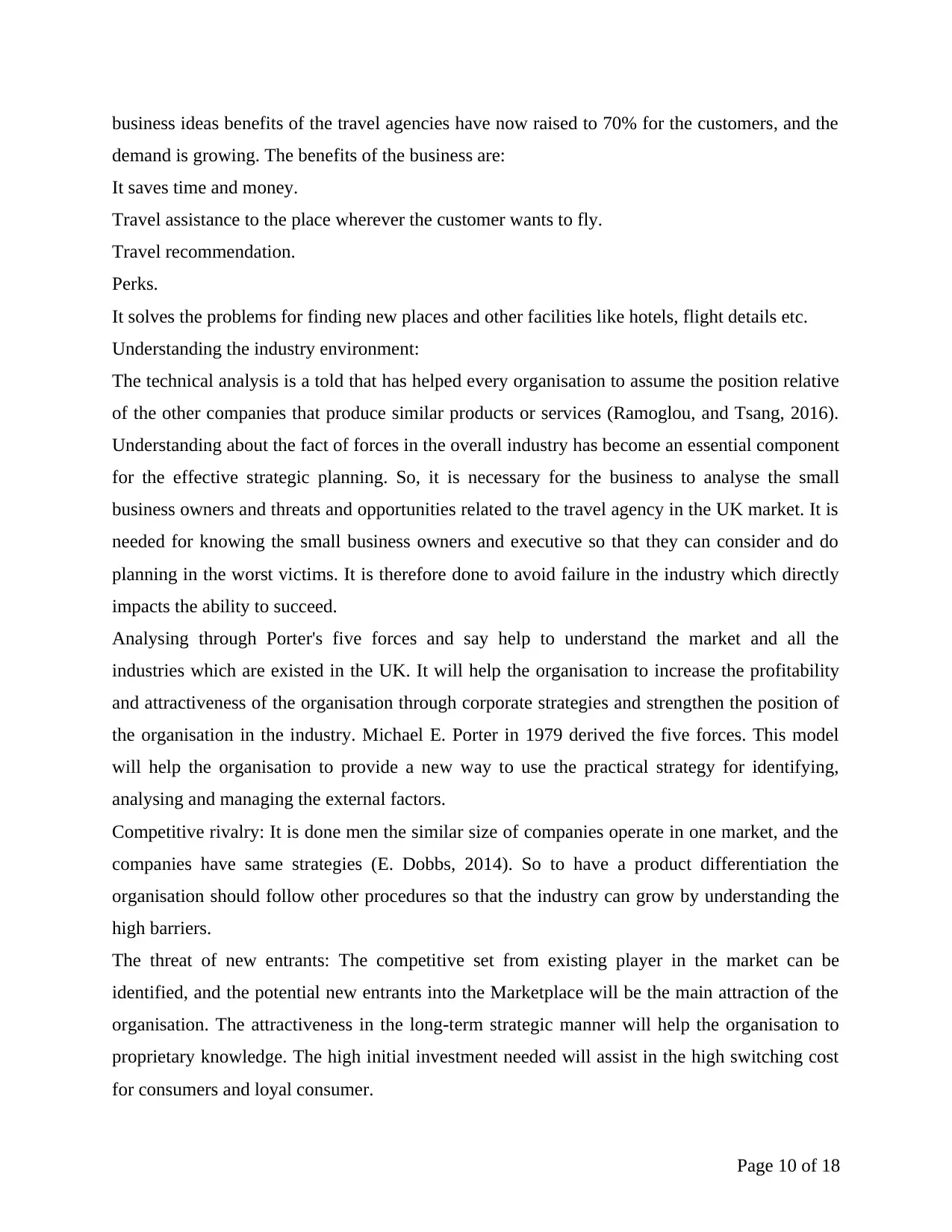
business ideas benefits of the travel agencies have now raised to 70% for the customers, and the
demand is growing. The benefits of the business are:
It saves time and money.
Travel assistance to the place wherever the customer wants to fly.
Travel recommendation.
Perks.
It solves the problems for finding new places and other facilities like hotels, flight details etc.
Understanding the industry environment:
The technical analysis is a told that has helped every organisation to assume the position relative
of the other companies that produce similar products or services (Ramoglou, and Tsang, 2016).
Understanding about the fact of forces in the overall industry has become an essential component
for the effective strategic planning. So, it is necessary for the business to analyse the small
business owners and threats and opportunities related to the travel agency in the UK market. It is
needed for knowing the small business owners and executive so that they can consider and do
planning in the worst victims. It is therefore done to avoid failure in the industry which directly
impacts the ability to succeed.
Analysing through Porter's five forces and say help to understand the market and all the
industries which are existed in the UK. It will help the organisation to increase the profitability
and attractiveness of the organisation through corporate strategies and strengthen the position of
the organisation in the industry. Michael E. Porter in 1979 derived the five forces. This model
will help the organisation to provide a new way to use the practical strategy for identifying,
analysing and managing the external factors.
Competitive rivalry: It is done men the similar size of companies operate in one market, and the
companies have same strategies (E. Dobbs, 2014). So to have a product differentiation the
organisation should follow other procedures so that the industry can grow by understanding the
high barriers.
The threat of new entrants: The competitive set from existing player in the market can be
identified, and the potential new entrants into the Marketplace will be the main attraction of the
organisation. The attractiveness in the long-term strategic manner will help the organisation to
proprietary knowledge. The high initial investment needed will assist in the high switching cost
for consumers and loyal consumer.
Page 10 of 18
demand is growing. The benefits of the business are:
It saves time and money.
Travel assistance to the place wherever the customer wants to fly.
Travel recommendation.
Perks.
It solves the problems for finding new places and other facilities like hotels, flight details etc.
Understanding the industry environment:
The technical analysis is a told that has helped every organisation to assume the position relative
of the other companies that produce similar products or services (Ramoglou, and Tsang, 2016).
Understanding about the fact of forces in the overall industry has become an essential component
for the effective strategic planning. So, it is necessary for the business to analyse the small
business owners and threats and opportunities related to the travel agency in the UK market. It is
needed for knowing the small business owners and executive so that they can consider and do
planning in the worst victims. It is therefore done to avoid failure in the industry which directly
impacts the ability to succeed.
Analysing through Porter's five forces and say help to understand the market and all the
industries which are existed in the UK. It will help the organisation to increase the profitability
and attractiveness of the organisation through corporate strategies and strengthen the position of
the organisation in the industry. Michael E. Porter in 1979 derived the five forces. This model
will help the organisation to provide a new way to use the practical strategy for identifying,
analysing and managing the external factors.
Competitive rivalry: It is done men the similar size of companies operate in one market, and the
companies have same strategies (E. Dobbs, 2014). So to have a product differentiation the
organisation should follow other procedures so that the industry can grow by understanding the
high barriers.
The threat of new entrants: The competitive set from existing player in the market can be
identified, and the potential new entrants into the Marketplace will be the main attraction of the
organisation. The attractiveness in the long-term strategic manner will help the organisation to
proprietary knowledge. The high initial investment needed will assist in the high switching cost
for consumers and loyal consumer.
Page 10 of 18
Secure Best Marks with AI Grader
Need help grading? Try our AI Grader for instant feedback on your assignments.
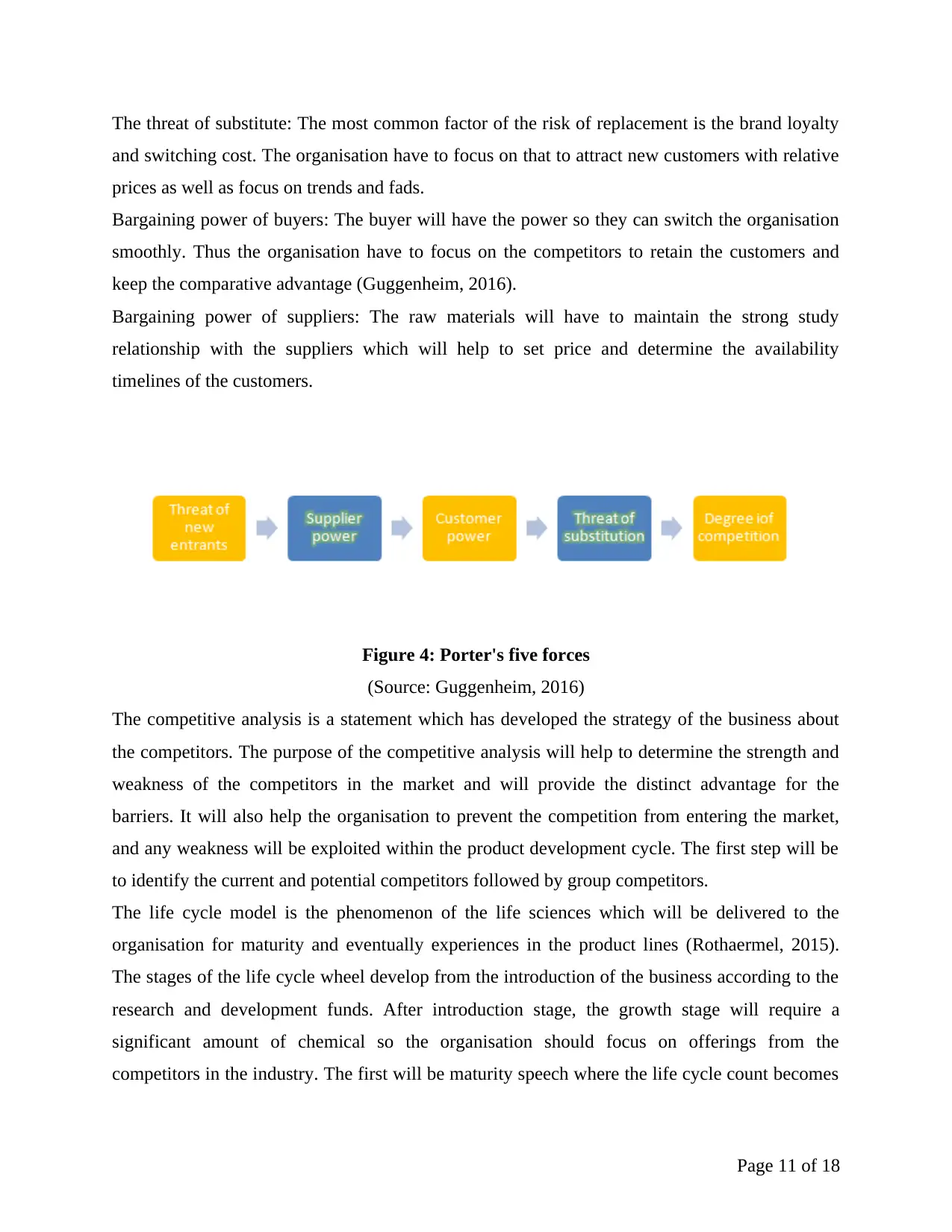
The threat of substitute: The most common factor of the risk of replacement is the brand loyalty
and switching cost. The organisation have to focus on that to attract new customers with relative
prices as well as focus on trends and fads.
Bargaining power of buyers: The buyer will have the power so they can switch the organisation
smoothly. Thus the organisation have to focus on the competitors to retain the customers and
keep the comparative advantage (Guggenheim, 2016).
Bargaining power of suppliers: The raw materials will have to maintain the strong study
relationship with the suppliers which will help to set price and determine the availability
timelines of the customers.
Figure 4: Porter's five forces
(Source: Guggenheim, 2016)
The competitive analysis is a statement which has developed the strategy of the business about
the competitors. The purpose of the competitive analysis will help to determine the strength and
weakness of the competitors in the market and will provide the distinct advantage for the
barriers. It will also help the organisation to prevent the competition from entering the market,
and any weakness will be exploited within the product development cycle. The first step will be
to identify the current and potential competitors followed by group competitors.
The life cycle model is the phenomenon of the life sciences which will be delivered to the
organisation for maturity and eventually experiences in the product lines (Rothaermel, 2015).
The stages of the life cycle wheel develop from the introduction of the business according to the
research and development funds. After introduction stage, the growth stage will require a
significant amount of chemical so the organisation should focus on offerings from the
competitors in the industry. The first will be maturity speech where the life cycle count becomes
Page 11 of 18
and switching cost. The organisation have to focus on that to attract new customers with relative
prices as well as focus on trends and fads.
Bargaining power of buyers: The buyer will have the power so they can switch the organisation
smoothly. Thus the organisation have to focus on the competitors to retain the customers and
keep the comparative advantage (Guggenheim, 2016).
Bargaining power of suppliers: The raw materials will have to maintain the strong study
relationship with the suppliers which will help to set price and determine the availability
timelines of the customers.
Figure 4: Porter's five forces
(Source: Guggenheim, 2016)
The competitive analysis is a statement which has developed the strategy of the business about
the competitors. The purpose of the competitive analysis will help to determine the strength and
weakness of the competitors in the market and will provide the distinct advantage for the
barriers. It will also help the organisation to prevent the competition from entering the market,
and any weakness will be exploited within the product development cycle. The first step will be
to identify the current and potential competitors followed by group competitors.
The life cycle model is the phenomenon of the life sciences which will be delivered to the
organisation for maturity and eventually experiences in the product lines (Rothaermel, 2015).
The stages of the life cycle wheel develop from the introduction of the business according to the
research and development funds. After introduction stage, the growth stage will require a
significant amount of chemical so the organisation should focus on offerings from the
competitors in the industry. The first will be maturity speech where the life cycle count becomes
Page 11 of 18
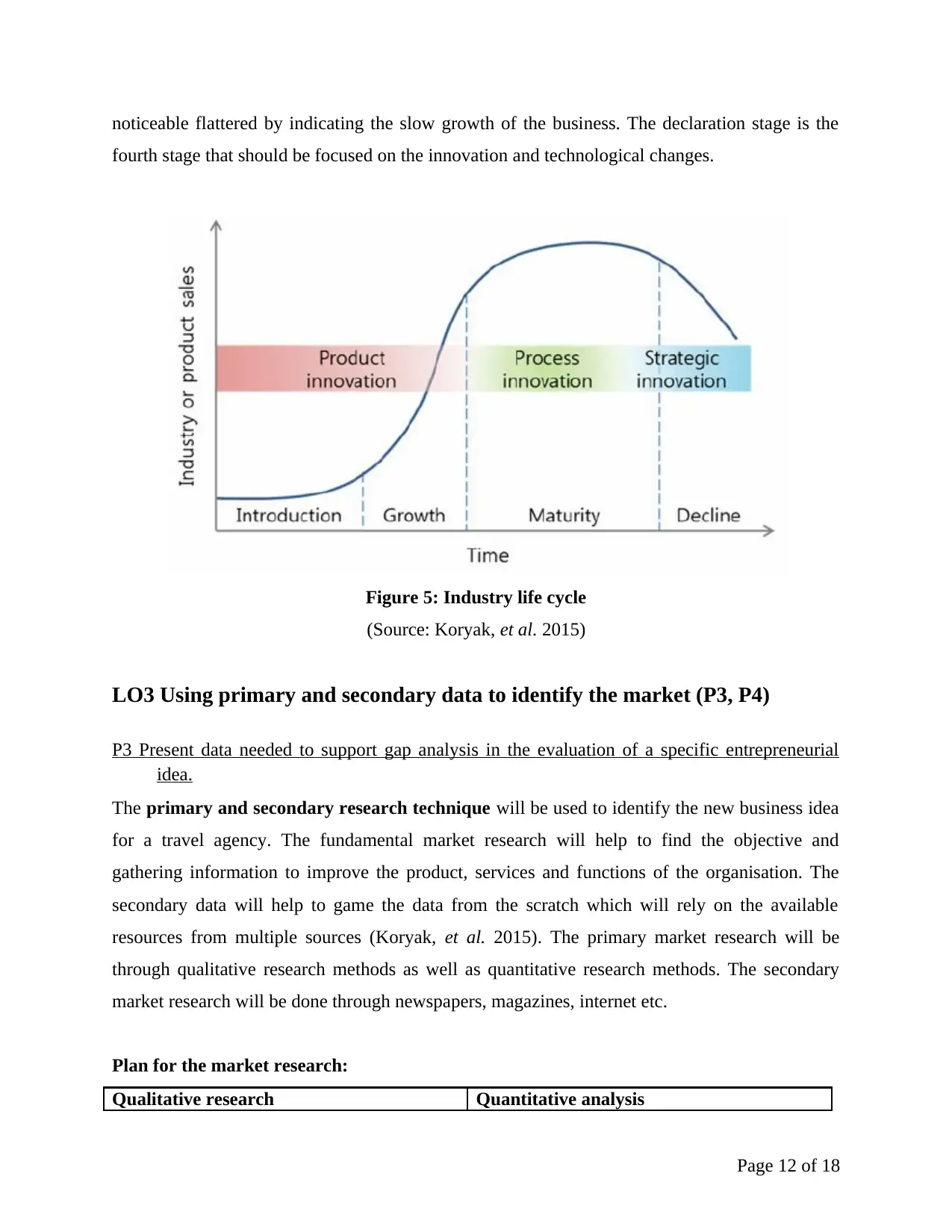
noticeable flattered by indicating the slow growth of the business. The declaration stage is the
fourth stage that should be focused on the innovation and technological changes.
Figure 5: Industry life cycle
(Source: Koryak, et al. 2015)
LO3 Using primary and secondary data to identify the market (P3, P4)
P3 Present data needed to support gap analysis in the evaluation of a specific entrepreneurial
idea.
The primary and secondary research technique will be used to identify the new business idea
for a travel agency. The fundamental market research will help to find the objective and
gathering information to improve the product, services and functions of the organisation. The
secondary data will help to game the data from the scratch which will rely on the available
resources from multiple sources (Koryak, et al. 2015). The primary market research will be
through qualitative research methods as well as quantitative research methods. The secondary
market research will be done through newspapers, magazines, internet etc.
Plan for the market research:
Qualitative research Quantitative analysis
Page 12 of 18
fourth stage that should be focused on the innovation and technological changes.
Figure 5: Industry life cycle
(Source: Koryak, et al. 2015)
LO3 Using primary and secondary data to identify the market (P3, P4)
P3 Present data needed to support gap analysis in the evaluation of a specific entrepreneurial
idea.
The primary and secondary research technique will be used to identify the new business idea
for a travel agency. The fundamental market research will help to find the objective and
gathering information to improve the product, services and functions of the organisation. The
secondary data will help to game the data from the scratch which will rely on the available
resources from multiple sources (Koryak, et al. 2015). The primary market research will be
through qualitative research methods as well as quantitative research methods. The secondary
market research will be done through newspapers, magazines, internet etc.
Plan for the market research:
Qualitative research Quantitative analysis
Page 12 of 18
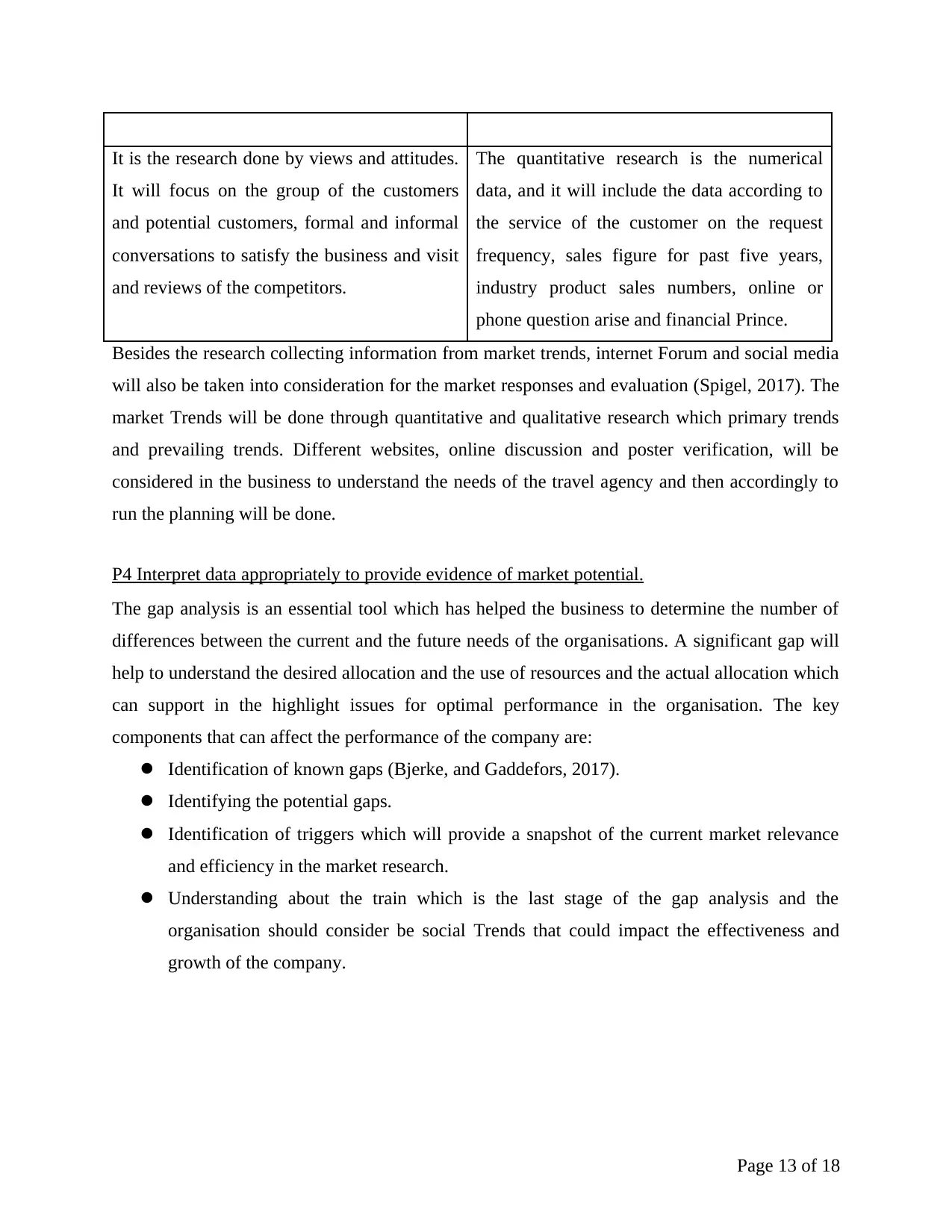
It is the research done by views and attitudes.
It will focus on the group of the customers
and potential customers, formal and informal
conversations to satisfy the business and visit
and reviews of the competitors.
The quantitative research is the numerical
data, and it will include the data according to
the service of the customer on the request
frequency, sales figure for past five years,
industry product sales numbers, online or
phone question arise and financial Prince.
Besides the research collecting information from market trends, internet Forum and social media
will also be taken into consideration for the market responses and evaluation (Spigel, 2017). The
market Trends will be done through quantitative and qualitative research which primary trends
and prevailing trends. Different websites, online discussion and poster verification, will be
considered in the business to understand the needs of the travel agency and then accordingly to
run the planning will be done.
P4 Interpret data appropriately to provide evidence of market potential.
The gap analysis is an essential tool which has helped the business to determine the number of
differences between the current and the future needs of the organisations. A significant gap will
help to understand the desired allocation and the use of resources and the actual allocation which
can support in the highlight issues for optimal performance in the organisation. The key
components that can affect the performance of the company are:
Identification of known gaps (Bjerke, and Gaddefors, 2017).
Identifying the potential gaps.
Identification of triggers which will provide a snapshot of the current market relevance
and efficiency in the market research.
Understanding about the train which is the last stage of the gap analysis and the
organisation should consider be social Trends that could impact the effectiveness and
growth of the company.
Page 13 of 18
It will focus on the group of the customers
and potential customers, formal and informal
conversations to satisfy the business and visit
and reviews of the competitors.
The quantitative research is the numerical
data, and it will include the data according to
the service of the customer on the request
frequency, sales figure for past five years,
industry product sales numbers, online or
phone question arise and financial Prince.
Besides the research collecting information from market trends, internet Forum and social media
will also be taken into consideration for the market responses and evaluation (Spigel, 2017). The
market Trends will be done through quantitative and qualitative research which primary trends
and prevailing trends. Different websites, online discussion and poster verification, will be
considered in the business to understand the needs of the travel agency and then accordingly to
run the planning will be done.
P4 Interpret data appropriately to provide evidence of market potential.
The gap analysis is an essential tool which has helped the business to determine the number of
differences between the current and the future needs of the organisations. A significant gap will
help to understand the desired allocation and the use of resources and the actual allocation which
can support in the highlight issues for optimal performance in the organisation. The key
components that can affect the performance of the company are:
Identification of known gaps (Bjerke, and Gaddefors, 2017).
Identifying the potential gaps.
Identification of triggers which will provide a snapshot of the current market relevance
and efficiency in the market research.
Understanding about the train which is the last stage of the gap analysis and the
organisation should consider be social Trends that could impact the effectiveness and
growth of the company.
Page 13 of 18
Paraphrase This Document
Need a fresh take? Get an instant paraphrase of this document with our AI Paraphraser
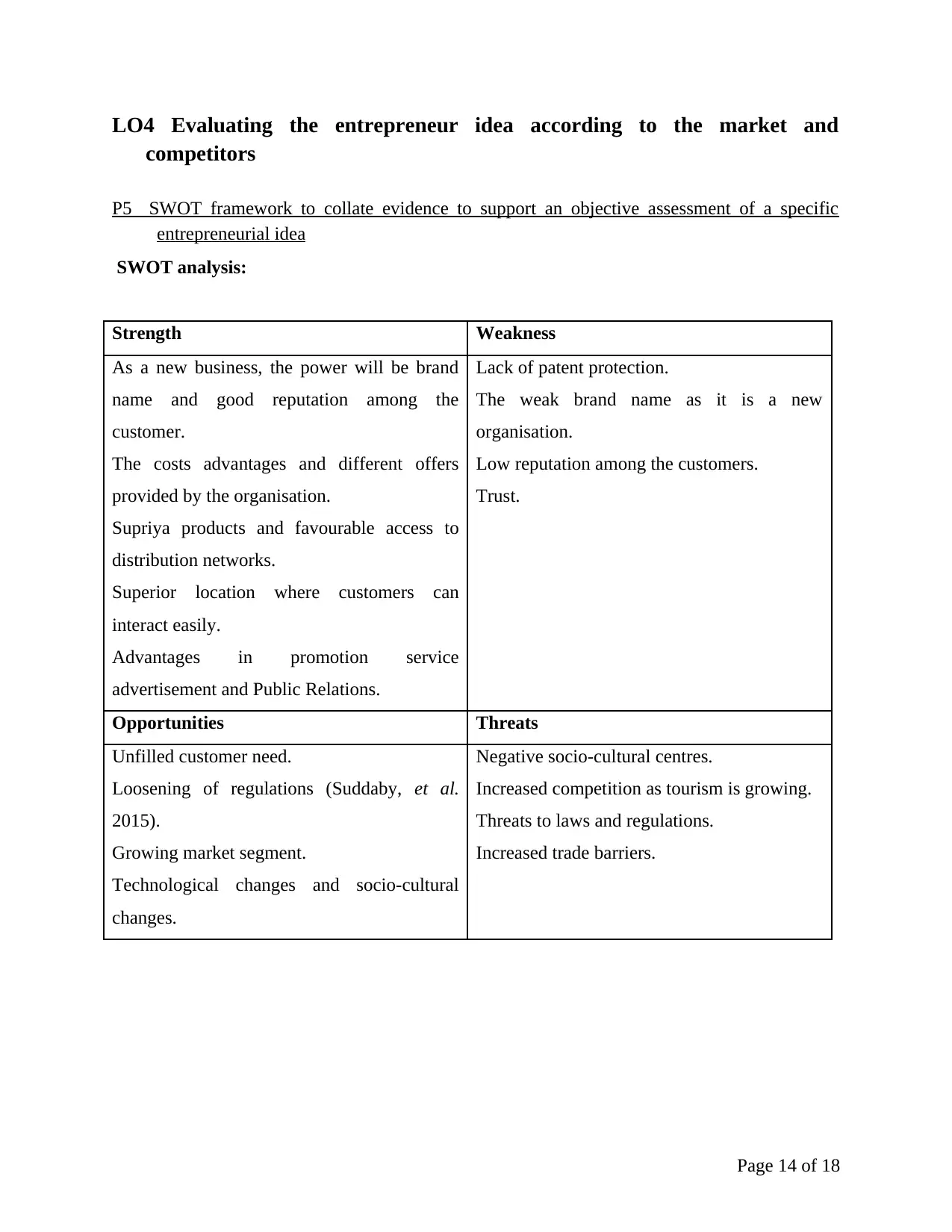
LO4 Evaluating the entrepreneur idea according to the market and
competitors
P5 SWOT framework to collate evidence to support an objective assessment of a specific
entrepreneurial idea
SWOT analysis:
Strength Weakness
As a new business, the power will be brand
name and good reputation among the
customer.
The costs advantages and different offers
provided by the organisation.
Supriya products and favourable access to
distribution networks.
Superior location where customers can
interact easily.
Advantages in promotion service
advertisement and Public Relations.
Lack of patent protection.
The weak brand name as it is a new
organisation.
Low reputation among the customers.
Trust.
Opportunities Threats
Unfilled customer need.
Loosening of regulations (Suddaby, et al.
2015).
Growing market segment.
Technological changes and socio-cultural
changes.
Negative socio-cultural centres.
Increased competition as tourism is growing.
Threats to laws and regulations.
Increased trade barriers.
Page 14 of 18
competitors
P5 SWOT framework to collate evidence to support an objective assessment of a specific
entrepreneurial idea
SWOT analysis:
Strength Weakness
As a new business, the power will be brand
name and good reputation among the
customer.
The costs advantages and different offers
provided by the organisation.
Supriya products and favourable access to
distribution networks.
Superior location where customers can
interact easily.
Advantages in promotion service
advertisement and Public Relations.
Lack of patent protection.
The weak brand name as it is a new
organisation.
Low reputation among the customers.
Trust.
Opportunities Threats
Unfilled customer need.
Loosening of regulations (Suddaby, et al.
2015).
Growing market segment.
Technological changes and socio-cultural
changes.
Negative socio-cultural centres.
Increased competition as tourism is growing.
Threats to laws and regulations.
Increased trade barriers.
Page 14 of 18
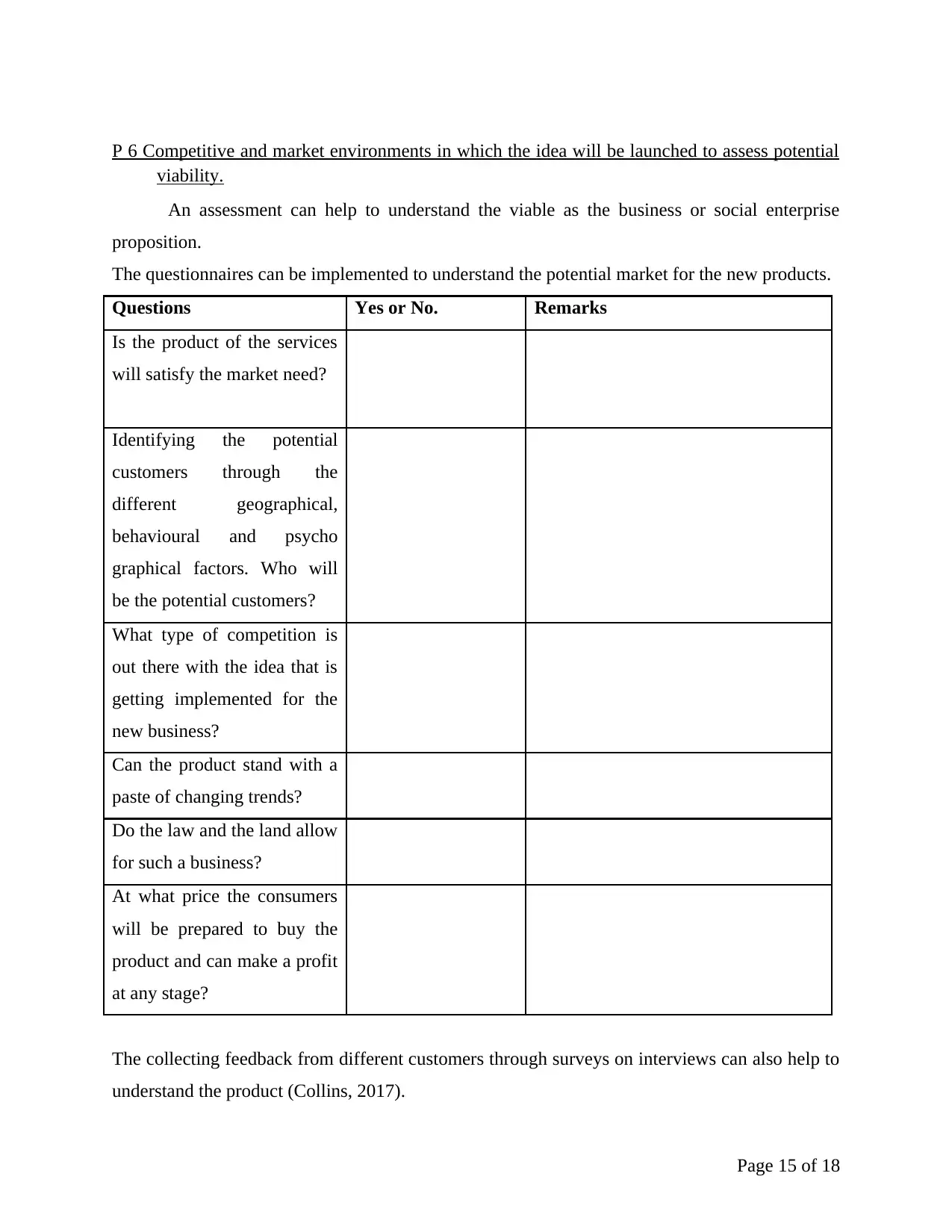
P 6 Competitive and market environments in which the idea will be launched to assess potential
viability.
An assessment can help to understand the viable as the business or social enterprise
proposition.
The questionnaires can be implemented to understand the potential market for the new products.
Questions Yes or No. Remarks
Is the product of the services
will satisfy the market need?
Identifying the potential
customers through the
different geographical,
behavioural and psycho
graphical factors. Who will
be the potential customers?
What type of competition is
out there with the idea that is
getting implemented for the
new business?
Can the product stand with a
paste of changing trends?
Do the law and the land allow
for such a business?
At what price the consumers
will be prepared to buy the
product and can make a profit
at any stage?
The collecting feedback from different customers through surveys on interviews can also help to
understand the product (Collins, 2017).
Page 15 of 18
viability.
An assessment can help to understand the viable as the business or social enterprise
proposition.
The questionnaires can be implemented to understand the potential market for the new products.
Questions Yes or No. Remarks
Is the product of the services
will satisfy the market need?
Identifying the potential
customers through the
different geographical,
behavioural and psycho
graphical factors. Who will
be the potential customers?
What type of competition is
out there with the idea that is
getting implemented for the
new business?
Can the product stand with a
paste of changing trends?
Do the law and the land allow
for such a business?
At what price the consumers
will be prepared to buy the
product and can make a profit
at any stage?
The collecting feedback from different customers through surveys on interviews can also help to
understand the product (Collins, 2017).
Page 15 of 18
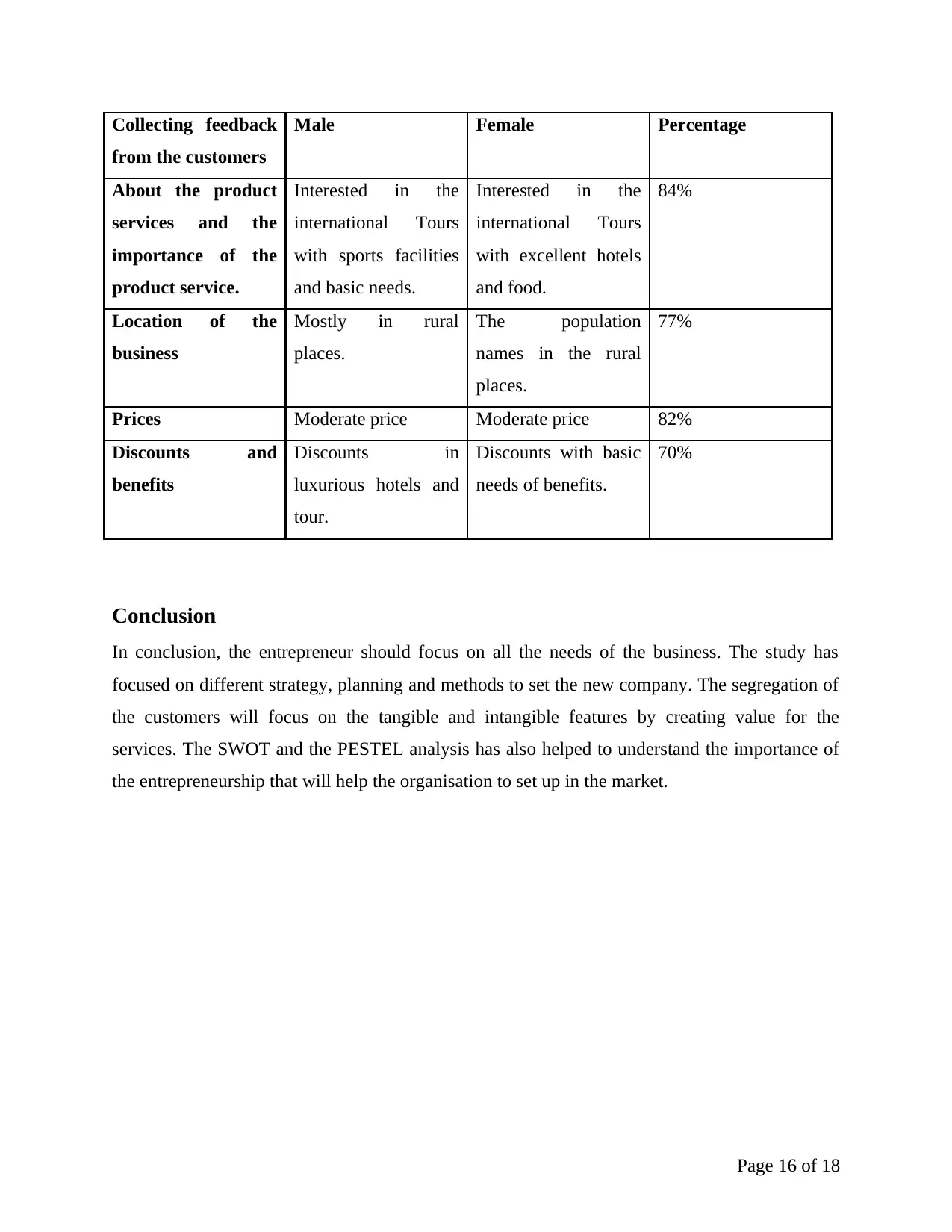
Collecting feedback
from the customers
Male Female Percentage
About the product
services and the
importance of the
product service.
Interested in the
international Tours
with sports facilities
and basic needs.
Interested in the
international Tours
with excellent hotels
and food.
84%
Location of the
business
Mostly in rural
places.
The population
names in the rural
places.
77%
Prices Moderate price Moderate price 82%
Discounts and
benefits
Discounts in
luxurious hotels and
tour.
Discounts with basic
needs of benefits.
70%
Conclusion
In conclusion, the entrepreneur should focus on all the needs of the business. The study has
focused on different strategy, planning and methods to set the new company. The segregation of
the customers will focus on the tangible and intangible features by creating value for the
services. The SWOT and the PESTEL analysis has also helped to understand the importance of
the entrepreneurship that will help the organisation to set up in the market.
Page 16 of 18
from the customers
Male Female Percentage
About the product
services and the
importance of the
product service.
Interested in the
international Tours
with sports facilities
and basic needs.
Interested in the
international Tours
with excellent hotels
and food.
84%
Location of the
business
Mostly in rural
places.
The population
names in the rural
places.
77%
Prices Moderate price Moderate price 82%
Discounts and
benefits
Discounts in
luxurious hotels and
tour.
Discounts with basic
needs of benefits.
70%
Conclusion
In conclusion, the entrepreneur should focus on all the needs of the business. The study has
focused on different strategy, planning and methods to set the new company. The segregation of
the customers will focus on the tangible and intangible features by creating value for the
services. The SWOT and the PESTEL analysis has also helped to understand the importance of
the entrepreneurship that will help the organisation to set up in the market.
Page 16 of 18
Secure Best Marks with AI Grader
Need help grading? Try our AI Grader for instant feedback on your assignments.
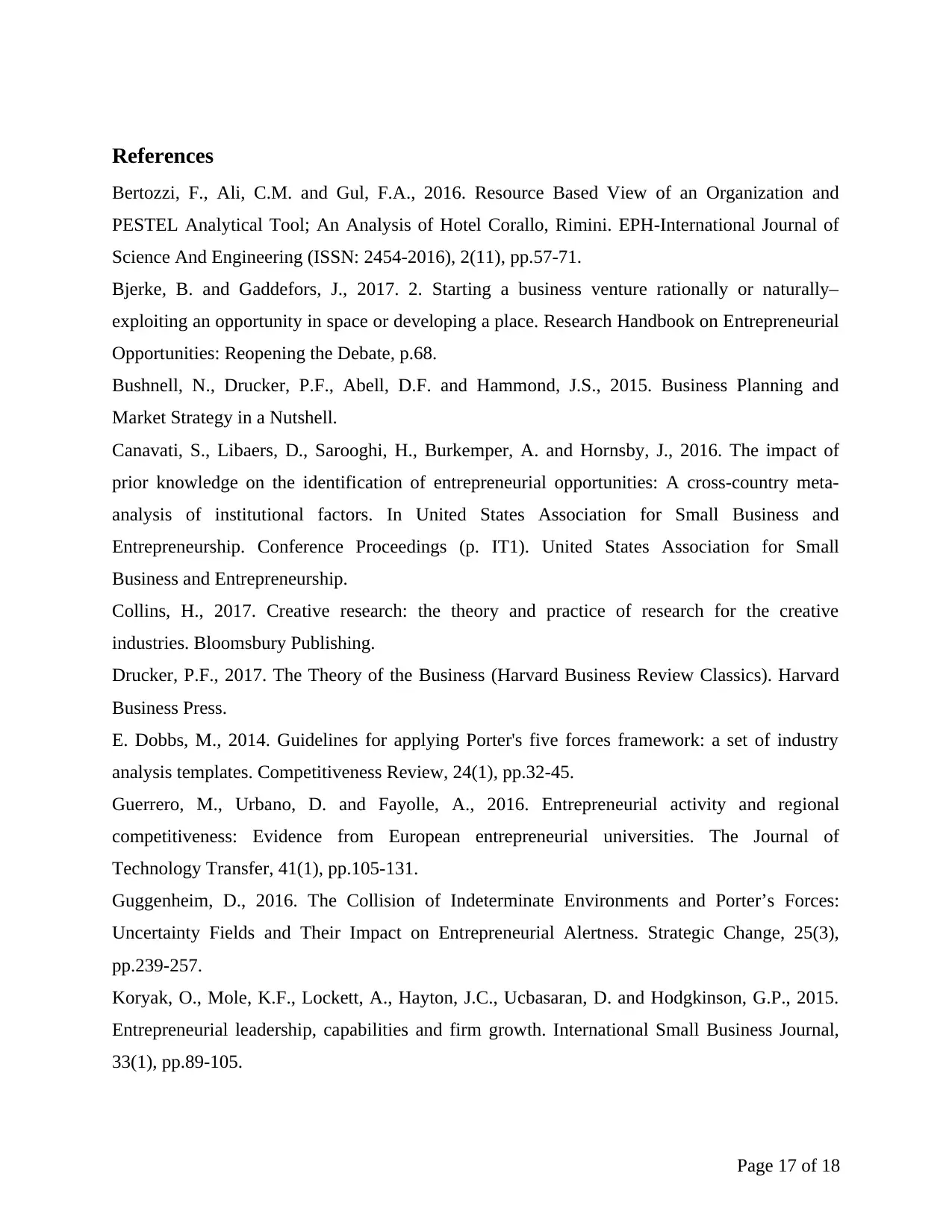
References
Bertozzi, F., Ali, C.M. and Gul, F.A., 2016. Resource Based View of an Organization and
PESTEL Analytical Tool; An Analysis of Hotel Corallo, Rimini. EPH-International Journal of
Science And Engineering (ISSN: 2454-2016), 2(11), pp.57-71.
Bjerke, B. and Gaddefors, J., 2017. 2. Starting a business venture rationally or naturally–
exploiting an opportunity in space or developing a place. Research Handbook on Entrepreneurial
Opportunities: Reopening the Debate, p.68.
Bushnell, N., Drucker, P.F., Abell, D.F. and Hammond, J.S., 2015. Business Planning and
Market Strategy in a Nutshell.
Canavati, S., Libaers, D., Sarooghi, H., Burkemper, A. and Hornsby, J., 2016. The impact of
prior knowledge on the identification of entrepreneurial opportunities: A cross-country meta-
analysis of institutional factors. In United States Association for Small Business and
Entrepreneurship. Conference Proceedings (p. IT1). United States Association for Small
Business and Entrepreneurship.
Collins, H., 2017. Creative research: the theory and practice of research for the creative
industries. Bloomsbury Publishing.
Drucker, P.F., 2017. The Theory of the Business (Harvard Business Review Classics). Harvard
Business Press.
E. Dobbs, M., 2014. Guidelines for applying Porter's five forces framework: a set of industry
analysis templates. Competitiveness Review, 24(1), pp.32-45.
Guerrero, M., Urbano, D. and Fayolle, A., 2016. Entrepreneurial activity and regional
competitiveness: Evidence from European entrepreneurial universities. The Journal of
Technology Transfer, 41(1), pp.105-131.
Guggenheim, D., 2016. The Collision of Indeterminate Environments and Porter’s Forces:
Uncertainty Fields and Their Impact on Entrepreneurial Alertness. Strategic Change, 25(3),
pp.239-257.
Koryak, O., Mole, K.F., Lockett, A., Hayton, J.C., Ucbasaran, D. and Hodgkinson, G.P., 2015.
Entrepreneurial leadership, capabilities and firm growth. International Small Business Journal,
33(1), pp.89-105.
Page 17 of 18
Bertozzi, F., Ali, C.M. and Gul, F.A., 2016. Resource Based View of an Organization and
PESTEL Analytical Tool; An Analysis of Hotel Corallo, Rimini. EPH-International Journal of
Science And Engineering (ISSN: 2454-2016), 2(11), pp.57-71.
Bjerke, B. and Gaddefors, J., 2017. 2. Starting a business venture rationally or naturally–
exploiting an opportunity in space or developing a place. Research Handbook on Entrepreneurial
Opportunities: Reopening the Debate, p.68.
Bushnell, N., Drucker, P.F., Abell, D.F. and Hammond, J.S., 2015. Business Planning and
Market Strategy in a Nutshell.
Canavati, S., Libaers, D., Sarooghi, H., Burkemper, A. and Hornsby, J., 2016. The impact of
prior knowledge on the identification of entrepreneurial opportunities: A cross-country meta-
analysis of institutional factors. In United States Association for Small Business and
Entrepreneurship. Conference Proceedings (p. IT1). United States Association for Small
Business and Entrepreneurship.
Collins, H., 2017. Creative research: the theory and practice of research for the creative
industries. Bloomsbury Publishing.
Drucker, P.F., 2017. The Theory of the Business (Harvard Business Review Classics). Harvard
Business Press.
E. Dobbs, M., 2014. Guidelines for applying Porter's five forces framework: a set of industry
analysis templates. Competitiveness Review, 24(1), pp.32-45.
Guerrero, M., Urbano, D. and Fayolle, A., 2016. Entrepreneurial activity and regional
competitiveness: Evidence from European entrepreneurial universities. The Journal of
Technology Transfer, 41(1), pp.105-131.
Guggenheim, D., 2016. The Collision of Indeterminate Environments and Porter’s Forces:
Uncertainty Fields and Their Impact on Entrepreneurial Alertness. Strategic Change, 25(3),
pp.239-257.
Koryak, O., Mole, K.F., Lockett, A., Hayton, J.C., Ucbasaran, D. and Hodgkinson, G.P., 2015.
Entrepreneurial leadership, capabilities and firm growth. International Small Business Journal,
33(1), pp.89-105.
Page 17 of 18
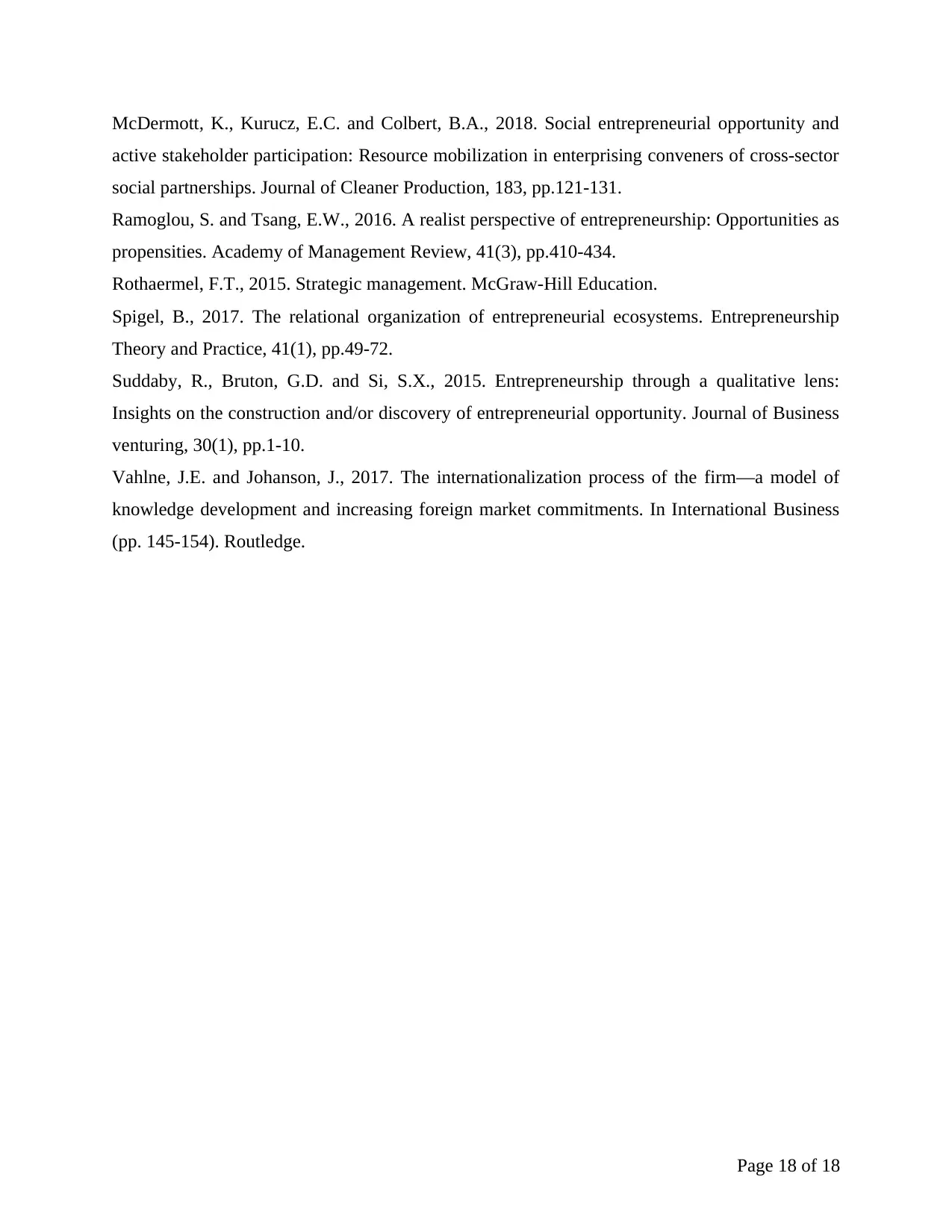
McDermott, K., Kurucz, E.C. and Colbert, B.A., 2018. Social entrepreneurial opportunity and
active stakeholder participation: Resource mobilization in enterprising conveners of cross-sector
social partnerships. Journal of Cleaner Production, 183, pp.121-131.
Ramoglou, S. and Tsang, E.W., 2016. A realist perspective of entrepreneurship: Opportunities as
propensities. Academy of Management Review, 41(3), pp.410-434.
Rothaermel, F.T., 2015. Strategic management. McGraw-Hill Education.
Spigel, B., 2017. The relational organization of entrepreneurial ecosystems. Entrepreneurship
Theory and Practice, 41(1), pp.49-72.
Suddaby, R., Bruton, G.D. and Si, S.X., 2015. Entrepreneurship through a qualitative lens:
Insights on the construction and/or discovery of entrepreneurial opportunity. Journal of Business
venturing, 30(1), pp.1-10.
Vahlne, J.E. and Johanson, J., 2017. The internationalization process of the firm—a model of
knowledge development and increasing foreign market commitments. In International Business
(pp. 145-154). Routledge.
Page 18 of 18
active stakeholder participation: Resource mobilization in enterprising conveners of cross-sector
social partnerships. Journal of Cleaner Production, 183, pp.121-131.
Ramoglou, S. and Tsang, E.W., 2016. A realist perspective of entrepreneurship: Opportunities as
propensities. Academy of Management Review, 41(3), pp.410-434.
Rothaermel, F.T., 2015. Strategic management. McGraw-Hill Education.
Spigel, B., 2017. The relational organization of entrepreneurial ecosystems. Entrepreneurship
Theory and Practice, 41(1), pp.49-72.
Suddaby, R., Bruton, G.D. and Si, S.X., 2015. Entrepreneurship through a qualitative lens:
Insights on the construction and/or discovery of entrepreneurial opportunity. Journal of Business
venturing, 30(1), pp.1-10.
Vahlne, J.E. and Johanson, J., 2017. The internationalization process of the firm—a model of
knowledge development and increasing foreign market commitments. In International Business
(pp. 145-154). Routledge.
Page 18 of 18
1 out of 18
Related Documents
Your All-in-One AI-Powered Toolkit for Academic Success.
+13062052269
info@desklib.com
Available 24*7 on WhatsApp / Email
![[object Object]](/_next/static/media/star-bottom.7253800d.svg)
Unlock your academic potential
© 2024 | Zucol Services PVT LTD | All rights reserved.





